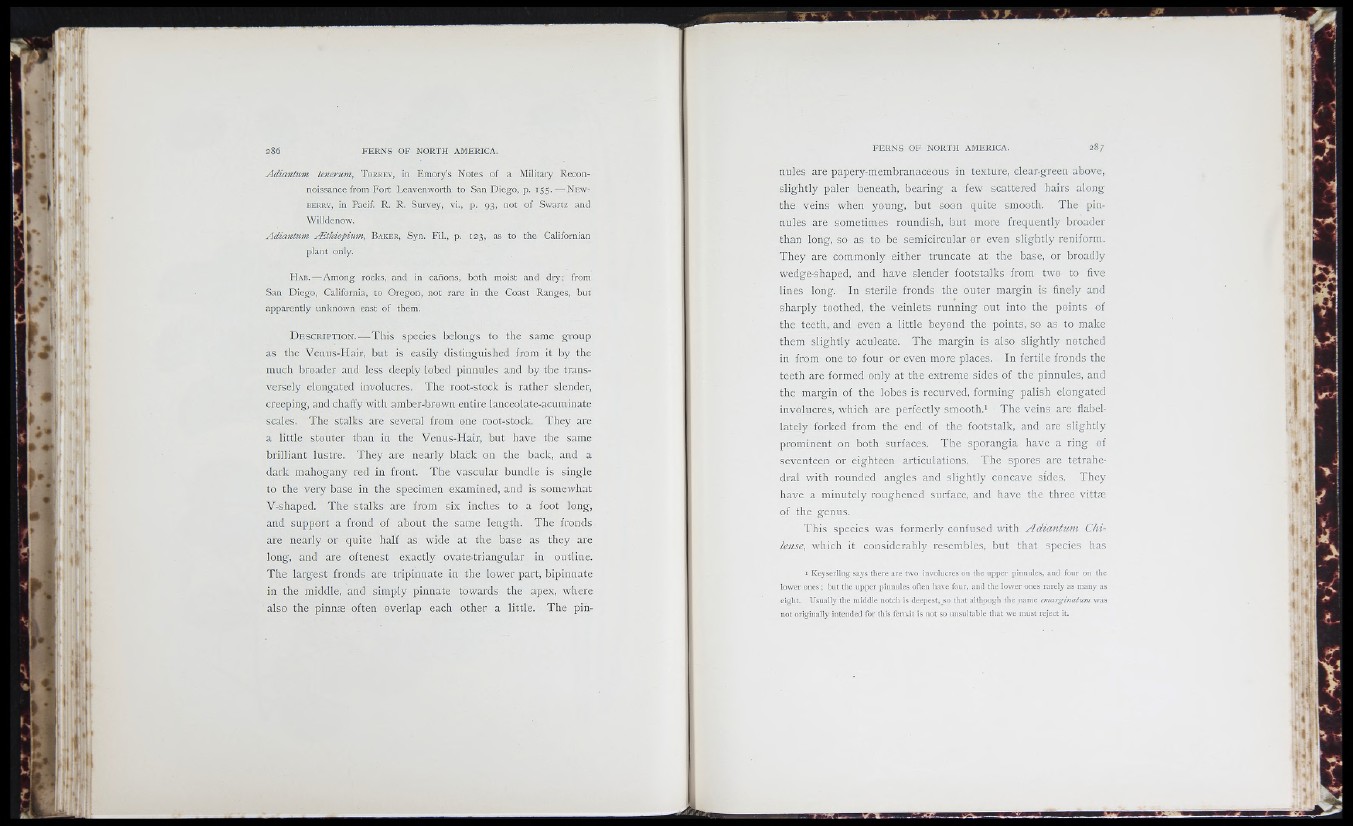
r ¿ i '
. *!
r . ' " I
*■ In
I tl
v | l I
t r F
i
, k l l
Adiantum tenerum, T o r r e y , in Emory's Notes o f a Military Recon-
noissance from Fort Leavenworth to San Diego, p. 155. — N ew b
e r r y , in Pacif. R. R. Survey, vi., p. 93, not of Swartz and
Willdenow.
Adiantum Æthiopium, B a k e r , Syn. Fil., p . 1 2 3 , as to th e Californian
plant only.
H a b.— Among rocks, and in canons, both moist and dry; from
San Diego, California, to Oregon, not rare in the Coast Ranges, but
apparently unknown east of them.
D e s c r i p t i o n . — This species belongs to the same group
as the Venus-EIair, but is easily distinguished from it by the
much broader and less deeply lobed pinnules and by the transversely
elongated involucres. The root-stock is rather slender,
creeping, and chaffy with amber-brown entire lanceolate-acuminate
scales. The stalks are several from one root-stock. They are
a little stouter than in the Venus-Hair, but have the same
brilliant lustre. They are nearly black on the back, and a
dark mahogany red in front. The vascular bundle is single
to the very base in the specimen examined, and is somewhat
V-shaped. The stalks are from six inches to a foot long,
and support a frond of about the same length. The fronds
are nearly or quite half as wide at the base as they are
long, and are oftenest exactly ovate-triangular in outline.
The largest fronds are tripinnate in the lower part, bipinnate
in the middle, and simply pinnate towards the apex, where
also the pinnæ often overlap each other a little. The pinÀ
nules are papery-membranaceous in texture, clear-green above,
slightly paler beneath, bearing a few scattered hairs along
the veins when young, but soon quite srnooth. The pinnules
are sometimes roundish, but more frequently broader
than long, so as to be semicircular or even slightly reniform.
They are commonly either truncate at the base, or broadly
wedge-shaped, and have slender footstalks from two to five
lines long. In sterile fronds the outer margin is finely and
sharply toothed, the veinlets running out into the points of
the teeth, and even a little beyond the points, so as to make
them slightly aculeate. The margin is also slightly notched
in from one to four or even more places. In fertile fronds the
teeth are formed only at the extreme sides of the pinnules, and
the margin of the lobes is recurved, forming palish elongated
involucres, which are perfectly smooth.1 The veins are flabellately
forked from the end of the footstalk, and are slightly
prominent on both surfaces. The sporangia have a ring of
seventeen or eighteen articulations. The spores are tetrahedral
with rounded angles and slightly concave sides. They
have a minutely roughened surface, and have the three vittæ
of the genus.
This species was formerly confused with Adimttum Chilense,
which it considerably resembles, but that species has
1 Keyse rling says there a re two involucres on the up p e r pinnules, and four on the
lowe r ones ; b u t the u p p e r pinnule s often have four, and th e lowe r ones rarely as many as
e ight. Usually th e middle notch is deepest, so th a t although th e name emarginatum was
not originally intended for this fern,it is n ot so unsuitable th a t we must reject it.